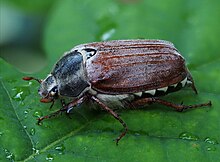
Back Melolontha melolontha AN دودة بيضاء Arabic ميلولونثا ميلولونثا ARZ Melolontha melolontha AST May böcəyi Azerbaijani Berža vombuolė BAT-SMG Майски бръмбари Bulgarian C'hwil-derv Breton Melolontha melolontha CEB Chroust obecný Czech
| Common cockchafer | |
|---|---|

| |
| Female | |
| Scientific classification | |
| Domain: | Eukaryota |
| Kingdom: | Animalia |
| Phylum: | Arthropoda |
| Class: | Insecta |
| Order: | Coleoptera |
| Family: | Scarabaeidae |
| Genus: | Melolontha |
| Species: | M. melolontha
|
| Binomial name | |
| Melolontha melolontha Linnaeus, 1758
| |
The common cockchafer (Melolontha melolontha), also colloquially known as the Maybug,[1][a] Maybeetle,[3] or doodlebug,[4] is a species of scarab beetle belonging to the genus Melolontha. It is native to Europe, and it is one of several closely-related and morphologically similar species of Melolontha called cockchafers, alongside Melolontha hippocastani (the forest cockchafer).
The adults and larvae feed on plants, and are regarded as serious agricultural pests of crops such as grasses and fruit trees. Adults have harmful effects for the crop when they aggregate in large group. The larvae can cause severe damage and kill the plant by gnawing the plant roots.[5] The cockchafer develops via metamorphosis, in which the beetle undergoes stages of egg, larvae, pupae and adults.
The mating behaviour is controlled by pheromone. The males usually swarm during the mating season while the females stay put and feed on leaves.[6] The leaves release green leaf volatiles when they are fed on by females, which the male can sense and thus locate the female for mating opportunity.[7][8] The larvae use both the plant volatiles and CO2 to locate the plant root for food. [9]
The number of cockchafers increased over the past few years due to the decrease in pesticide usage. Soil tilling can be used to remove larvae hatching.[10] Entomopathogenic fungi[11] and nematodes[10] can effectively remove beetles at larvae stage.
- ^ a b "Common Cockchafer". Bug Life.
- ^ Marren, Peter; Mabey, Richard (2010). Bugs Britannica. Chatto & Windus. ISBN 978-0-7011-8180-2.
- ^ "Cockchafer | insect". Encyclopedia Britannica. Retrieved 2021-07-01.
- ^ "7 things you never knew about the cockchafer". Discover Wildlife. 8 April 2014. Retrieved 4 July 2016.
- ^ Fraval, A. (1998). "HYPP Zoology".
- ^ Cite error: The named reference
:0was invoked but never defined (see the help page). - ^ Cite error: The named reference
:2was invoked but never defined (see the help page). - ^ Cite error: The named reference
:3was invoked but never defined (see the help page). - ^ Cite error: The named reference
:1was invoked but never defined (see the help page). - ^ a b Cite error: The named reference
:5was invoked but never defined (see the help page). - ^ Cite error: The named reference
:9was invoked but never defined (see the help page).
Cite error: There are <ref group=lower-alpha> tags or {{efn}} templates on this page, but the references will not show without a {{reflist|group=lower-alpha}} template or {{notelist}} template (see the help page).